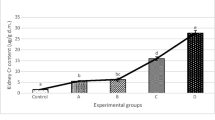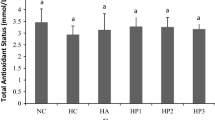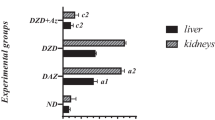Abstract
This study was designed to investigate the effects of Nigella sativa L. (NS), known as black seed, or/and Urtica dioica L. (UD), known as stinging nettle root, treatments on serum Na, K, Cl, and Ca levels and some hematological values of CCl4-treated rats. Sixty healthy male Sprague-Dawley rats, weighing 250–300 g, were randomly allotted into 1 of 4 experimental groups: A (CCl4-only treated), B (CCl4+UD treated), C (CCl4+NS treated), and D (CCl4+UD+NS treated), each containing 15 animals. All groups received CCl4 (0.8 mL/kg of body weight, subcutaneously, twice a week for 90 d starting d 1). In addition, B, C, and D groups also received the daily ip injection of 0.2 mL/kg NS and/or 2 mL/kg UD oils for 45 d starting d 46. Group A, on the other hand, received only 2 mL/kg normal saline solution for 45 d starting d 46. Blood samples for the biochemical analysis were taken by cardiac puncture from five randomly chosen rats in each treatment group at the beginning, d 45, and d 90 of the experiment. The CCl4 treatment for 45 d significantly (p<0.05) increased the serum K and Ca and decreased (p<0.05) the red blood cell count (RBC), white blood cell count (WBC), packed cell volume (PCV), and Hb levels without changing (p>0.05) the serum Na and Cl levels. NS or UD treatments (alone or combination) for 45 d starting d 46 significantly (p<0.05) decreased the elevated serum K and Ca levels and also increased (p<0.05) the reduced RBC, WBC, PCV, and Hb levels. It is concluded that NS and/or UD treatments might ameliorate the CCl4-induced disturbances of anemia, some minerals, and body’s defense mechanism in CCl4-treated rats.
Similar content being viewed by others
References
M. Parola, G. Leonarduzzi, F. Biasi, et al., Vitamin E dietary supplementation protects against carbon tetrachloride-induced chronic liver damage and cirrhosis. Hepatology 16, 1014–1021 (1992).
K. E. H. El-Tahir, M. M. S. Ashour, and M. M. Al-Harbi, The respiratory effects of the volatile oil of the black seed (Nigella sativa) in guinea-pigs: elucidation of the mechanism(s) of action. Gen. Pharmacol. 24, 1115–1122 (1993).
A. El-Kadi and O. Kandil, The black seed (Nigella sativa) and immunity: its effect on human T cell subset. Fed. Proc. 46, 1222 (1987).
M. S. M. Hanafy and M. E. Hatem, Studies on the antimicrobial activity of Nigella sativa seed (black cumin). J. Ethnopharmacol. 34, 275–278 (1991).
A. Zaoui, Y. Cherrah, M. A. Lacaille-Dubois, A. Settaf, H. Amarouch, and M. Hassar, Diuretic and hypotensive effects of Nigella sativa in the spontaneously hypertensive rat. Therapie 55, 379–382 (2000).
N. Salomi, S. C. Nair, K. K. Jayawarahanan, and C. D. Varghese, Antitumor principles from Nigella sativa seeds. Johns Hopkins Alumni Magazine 63, 33–36 (1992).
T. Teucher, B. Obertreis, T. Ruttkowski, and H. Schmitz, Cytokine secretion in whole blood of healthy subjects following oral administration of Urtica dioica L. plant extract. Arzneimittelforschung 46, 906–910 (1996).
K. Riehemann, B. Behnke, and K. Schulze-Osthoff, Plant extract from stinging nettle (Urtica dioica), an antirheumatic remedy, inhibits the proinflammatory transcription factor NF-kappa B. FEBS Lett. 442, 89–94 (1999).
H. Wagner, F. Willer, and B. Kreher, Biologically active compounds from the aqueos extract of Urtica diotica. Planta Med. 55, 452–454 (1989).
T. Intragumtornchai, P. Rojnukkarin, D. Swasdikul, C. Vajanamarhutue, and S. Israsena, Anemias in Thai patients with cirrhosis. Int. J. Hematol. 65, 365–373 (1997).
K. C. Thresiamma and R. Kuttan, Inhibition of liver fibrosisby ellagic acid. Indian J. Physiol. Pharmacol. 40, 363–366 (1996).
T. M. Worner and C. S. Lieber, Perivenular fibrosis as precursor lesion of cirrhosis. JAMA 254, 627–630 (1985).
H. J. Merselman, Morphological determinants of red cell deformability. Scand. J. Clin. Lab. Invest. 156(Suppl.) 27 (1981).
W. F. Ganong, Review of Medical Physiology 15th ed., p. 431–480, Lange Medical Publications, East Norwalk, CT, p. 431–480 (1991).
S. Vasilopoulos, R. Hally, J. Caro, et al., Erythropoietin response to post-liver transplantation anemia. Liver Transpl. 6, 349–355 (2000).
C. Fiuza, M. Salcedo, G. Clemente, and J. M. Tellado, In vivo neutrophil dysfunction in cirrhotic patients with advanced liver disease. J. Infect. Dis. 182, 526–533 (2000).
F. N. Bashour, J. C. Teran, and K. D. Mullen, Prevalence of peripheral blood cytopenias (hypersplenism) in patients with nonalcoholic chronic liver disease. Am. J. Gastroenterol. 95, 2936–2939 (2000).
A. Bavdekar, S. Bhave, and A. Pandit, Nutrition management in chronic liver disease. Indian J. Pediatr. 69, 427–431 (2002).
A. O. Miroshnichenko, V. P. Liashenko, and S. M. Lukashov, Effects of different types of stress on the accumulation of calcium in the liver, and its functional activity. Fiziol. Zh. 48, 22–27 (2002).
H. J. Milionis and M. S. Elisaf, Hyperkalaemia in a patient with hepatic cirrhosis. Nephrol. Dial. Transplant. 14, 2505–2506 (1999).
Author information
Authors and Affiliations
Rights and permissions
About this article
Cite this article
Meral, I., Kanter, M. Effects of Nigella sativa L. and Urtica dioica L. on selected mineral status and hematological values in CCl4-treated rats. Biol Trace Elem Res 96, 263–270 (2003). https://doi.org/10.1385/BTER:96:1-3:263
Received:
Revised:
Accepted:
Issue Date:
DOI: https://doi.org/10.1385/BTER:96:1-3:263




